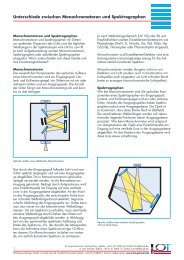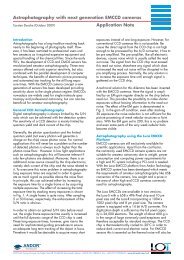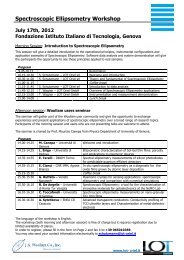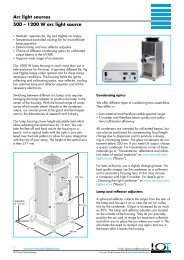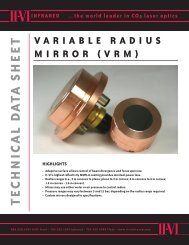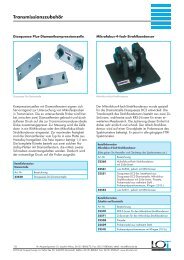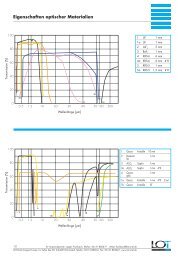Arc light sources All you need to know about arc lamps - L.O.T.-Oriel
Arc light sources All you need to know about arc lamps - L.O.T.-Oriel
Arc light sources All you need to know about arc lamps - L.O.T.-Oriel
You also want an ePaper? Increase the reach of your titles
YUMPU automatically turns print PDFs into web optimized ePapers that Google loves.
<strong>Arc</strong> <strong>light</strong> <strong>sources</strong><br />
<strong>All</strong> <strong>you</strong> <strong>need</strong> <strong>to</strong> <strong>know</strong> <strong>about</strong> <strong>arc</strong> <strong>lamps</strong><br />
Not considering lasers, short <strong>arc</strong> <strong>lamps</strong> are the brightest<br />
manufactured <strong>sources</strong>. Light is generated by a<br />
discharge <strong>arc</strong> burning in gas between two electrodes.<br />
This lamp type has two remarkable features:<br />
n High output in the UV-VIS<br />
n Small radiating <strong>arc</strong> region<br />
Because the <strong>arc</strong> region is very small, for many applications<br />
these <strong>lamps</strong> come very close <strong>to</strong> the ideal of a<br />
point source.<br />
The extremely bright and high-radiance <strong>sources</strong> are<br />
very suitable for creating a collimated beam or for<br />
irradiating small probes with high intensity. Mercury<br />
<strong>arc</strong> <strong>lamps</strong> emit 60% of their output in the UV-VIS. Xe<br />
<strong>arc</strong> <strong>lamps</strong> have a color temperature of approx. 6000 K<br />
which is close <strong>to</strong> that of the sun. The main output is<br />
below 900 nm.<br />
<strong>Arc</strong> lamp design<br />
The figures on the next page show the design of typical<br />
<strong>arc</strong> <strong>lamps</strong>. The lamp bulbs are always made of quartz<br />
glass. Only quartz glass can withstand the high mechanical<br />
load caused by the operating pressure of some<br />
tens of bars and the thermal load at surface temperatures<br />
of over 700° C. The type of quartz determines<br />
the lamp‘s UV output. Most <strong>lamps</strong> use doped or coated<br />
quartz which absorbs below 250 nm <strong>to</strong> prevent ozone<br />
generation. They are called „ozone-free“ <strong>lamps</strong>. Others<br />
use UV grade quartz <strong>to</strong> transmit output down <strong>to</strong> 200<br />
or even 160 nm. Depending on the type and dominant<br />
application, a more oval or more round cross section is<br />
chosen. The quartz wall is a few millimeters thick.<br />
Electrodes<br />
The electrodes are always made of tungsten. The<br />
cathode supplies the electrons. The best material for<br />
performing this task is doped tungsten. The cathode is<br />
small with a relatively sharp tip <strong>to</strong> enhance the emission<br />
of electrons. Its shape also has a great influence<br />
on the <strong>arc</strong> size and stability.<br />
The anode receives the electrons emitted by the cathode.<br />
They penetrate the anode at high speed which is<br />
converted <strong>to</strong> heat. This heat must be dissipated, and is<br />
mostly radiated away. To keep the anode’s temperature<br />
as low as possible the anode is bigger than the cathode.<br />
This ensures a long lamp life. Hg <strong>lamps</strong> have coils<br />
on one or both electrodes <strong>to</strong> help with the <strong>arc</strong> formation.<br />
The anode-cathode gap can be from 0.25 mm <strong>to</strong><br />
several mm, depending on the lamp power.<br />
1<br />
Gas fill<br />
Xe <strong>lamps</strong> are filled with pure xenon gas at 8 <strong>to</strong> 10 bar.<br />
Mercury <strong>lamps</strong> are filled with an inert gas with a<br />
precisely metered amount of mercury. This amount is<br />
calculated in such a way that, depending on power<br />
and bulb shape, a pressure of up <strong>to</strong> 75 bar is reached<br />
during operation. For Xe <strong>lamps</strong> the internal pressure<br />
rises <strong>to</strong> <strong>about</strong> 30 <strong>to</strong> 40 bar during operation. The high<br />
operating pressure is related <strong>to</strong> the high operating<br />
temperature of the lamp. This demands special care in<br />
handling and operation of the <strong>lamps</strong>.<br />
Bases<br />
The two metal bases at the ends of the lamp are for<br />
electrical connection and mechanical fixing of the<br />
lamp. The bases are connected <strong>to</strong> the electrodes by<br />
a molybdenum foil inside the glass stem, or, for the<br />
higher wattage <strong>lamps</strong>, by tungsten rods. Tungsten has<br />
a high thermal expansion coefficient, but quartz does<br />
not expand at all when heated. So certain tricks have<br />
<strong>to</strong> be employed <strong>to</strong> create a seal between the glass and<br />
the metal.<br />
www.lot-oriel.com/<strong>light</strong><strong>sources</strong> E-mail: <strong>light</strong><strong>sources</strong>@lot-oriel.com<br />
LOT-<strong>Oriel</strong> Group Europe. For <strong>you</strong>r local contact click at www.lot-oriel.com
<strong>Arc</strong> <strong>light</strong> <strong>sources</strong><br />
<strong>All</strong> <strong>you</strong> <strong>need</strong> <strong>to</strong> <strong>know</strong> <strong>about</strong> <strong>arc</strong> <strong>lamps</strong><br />
Xe short <strong>arc</strong> <strong>lamps</strong><br />
n Continuous output from UV-VIS<br />
n Simulation of solar spectrum<br />
Xe <strong>lamps</strong> are filled with pure xenon gas at 8 – 10 bars.<br />
The pressure triples during operation. Xe <strong>lamps</strong> operate<br />
with the anode at the <strong>to</strong>p. With 6000 – 6500 K they<br />
closely approach the color temperature of the sun. The<br />
xenon lines dominate between 750 and 1000 nm, but<br />
the spectrum is almost smooth through the ultraviolet and<br />
visible.<br />
Special UV versions emit down <strong>to</strong> 160 nm. Ozone free<br />
<strong>lamps</strong> have bulbs that absorb below 300 nm and have<br />
a cut-off around 250 nm. For lamp spectra go <strong>to</strong>”Lamp<br />
spectra and irradiance data“ on<br />
www.lot-oriel.com/<strong>light</strong><strong>sources</strong> (“Basics“).<br />
2<br />
Quartz body<br />
Xe<br />
(with small<br />
amount of<br />
Hg for Hg(Xe))<br />
Ignition wire<br />
Base<br />
Xe- and Hg(Xe) <strong>arc</strong> lamp<br />
Hg <strong>arc</strong> lamp<br />
Quartz body<br />
Starter gas<br />
with mercury<br />
Base<br />
Anode<br />
Cathode<br />
Molybdenum foil<br />
Cathode<br />
Anode<br />
Mercury <strong>arc</strong> <strong>lamps</strong><br />
n Spectral lines with high output in the UV<br />
Mercury <strong>arc</strong> <strong>lamps</strong> contain a ground gas (such as argon<br />
or xenon) and liquid mercury. The mercury vaporizes<br />
under high pressure up <strong>to</strong> several 10 bars by the<br />
operating temperature, produced when the discharge<br />
is switched on. After ignition, a diffusely shining discharge<br />
in the ground gas can be seen which decreases<br />
along with the increasing mercury vapor pressure.<br />
Hg <strong>lamps</strong> require a start-up time of up <strong>to</strong> 20 minutes<br />
before the mercury is completely vaporized. After that<br />
the lamp is in thermal balance and the lamp current is<br />
constant.<br />
Mercury <strong>lamps</strong> operate with the anode at the bot<strong>to</strong>m.<br />
This ensures proper vaporization of the mercury.<br />
Because the bulb temperature has a great influence<br />
on the mercury pressure, these <strong>lamps</strong> are sensitive <strong>to</strong><br />
airflow. The output spectrum of these <strong>lamps</strong> is dominated<br />
by strong mercury lines through the visible and<br />
ultraviolet with a weak continuum in the infrared of up<br />
<strong>to</strong> 2.5 μm.<br />
Mercury (Xe) <strong>lamps</strong><br />
n Spectral lines with high output in the UV<br />
n Deep UV output<br />
Mercury (xenon) <strong>lamps</strong> are especially designed <strong>to</strong> provide<br />
high output in the “deep UV“ i.e. below 320 nm.<br />
Compared <strong>to</strong> Hg <strong>arc</strong> <strong>lamps</strong> the spectrum in the UV is<br />
higher in intensity and sharper in width. They provide<br />
output below 250 nm which Hg <strong>arc</strong> <strong>lamps</strong> do not.<br />
These <strong>lamps</strong> use xenon at above atmospheric pressure<br />
as ground gas and operate with the anode at the<br />
<strong>to</strong>p.<br />
In terms of stability and cooling, Hg(Xe) <strong>lamps</strong> are generally<br />
less complicated <strong>to</strong> operate than Hg <strong>lamps</strong>. Also,<br />
their life time is higher.<br />
www.lot-oriel.com/<strong>light</strong><strong>sources</strong> E-mail: <strong>light</strong><strong>sources</strong>@lot-oriel.com<br />
LOT-<strong>Oriel</strong> Group Europe. For <strong>you</strong>r local contact click at www.lot-oriel.com
<strong>Arc</strong> <strong>light</strong> <strong>sources</strong><br />
<strong>All</strong> <strong>you</strong> <strong>need</strong> <strong>to</strong> <strong>know</strong> <strong>about</strong> <strong>arc</strong> <strong>lamps</strong><br />
Handling and operating of <strong>arc</strong> <strong>lamps</strong><br />
<strong>Arc</strong> <strong>lamps</strong> must only be operated in suitable closed<br />
housings. The lamp housing must protect the environment<br />
from UV radiation (and scattered <strong>light</strong>) and from<br />
glare from the <strong>arc</strong>. The highly pressured short <strong>arc</strong><br />
<strong>lamps</strong> may unexpectedly shatter or explode. In case<br />
of lamp explosion no glass fragments must leave the<br />
housing. Proper handling of the lamp is essential. The<br />
quartz body must be protected from scratches and<br />
abrasions. Even the smallest size scratch that may not<br />
be visible <strong>to</strong> the naked eye, may lead <strong>to</strong> the build-up of<br />
strain which can lead <strong>to</strong> an explosive failure.<br />
Special attention should be paid <strong>to</strong> the mechanical<br />
fixing of the lamp. To compensate for the expansion of<br />
the housing when it heats up, the lamp must be fixed<br />
tightly at one end only. The other end should be a flexible<br />
cable. Proper cooling of the lamp is essential. If<br />
<strong>arc</strong> <strong>lamps</strong> are not cooled sufficiently they may explode!<br />
Our lamp housings provide optimal and necessary<br />
conditions <strong>to</strong> operate <strong>arc</strong> <strong>lamps</strong>.<br />
The following points must be observed:<br />
3<br />
n Correct polarity<br />
n Correct lamp current<br />
n Correct burning position<br />
n Our <strong>arc</strong> <strong>lamps</strong> are DC current <strong>lamps</strong> and are<br />
designed for a vertical burning position only.<br />
n Always operate our Xe and Hg(Xe) <strong>lamps</strong> with<br />
the anode at the <strong>to</strong>p.<br />
n Always operate our Hg-<strong>lamps</strong> with the anode<br />
at the bot<strong>to</strong>m.<br />
Following these rules will au<strong>to</strong>matically lead <strong>to</strong> the<br />
right polarity. Our lamp housings are universal. They<br />
operate both Xe, Hg(Xe) and Hg <strong>arc</strong> <strong>lamps</strong>. A wrong<br />
polarity will destroy the lamp immediately, because<br />
the cathode will melt. Always pay attention <strong>to</strong> the correct<br />
lamp current. The <strong>lamps</strong> operate optimal at rated<br />
current only. The values can be found in “<strong>Arc</strong> <strong>lamps</strong>,<br />
specifications“ on www.lot-oriel.com/<strong>light</strong><strong>sources</strong> (“<strong>Arc</strong><br />
<strong>light</strong> <strong>sources</strong>“).<br />
Never <strong>to</strong>uch the bulb or shaft with bare fingers. Clean<br />
the lamp with a lint-free cloth moistened with alcohol<br />
(spirit). Take care not <strong>to</strong> scratch the glass surface.<br />
If fingerprints are not removed they will cause permanent<br />
etching on the quartz surface and act as a seed<br />
for ongoing recrystallization of the glass. The glass will<br />
loose its strength and this increases the risk of lamp<br />
explosion.<br />
Operating conditions<br />
Our <strong>arc</strong> <strong>lamps</strong> require DC-current. The power supplies<br />
must supply an open circuit voltage which is greater<br />
than the lamp voltage by a fac<strong>to</strong>r 3 <strong>to</strong> 4. When cold,<br />
<strong>arc</strong> <strong>lamps</strong> are electrical isola<strong>to</strong>rs. The gas between the<br />
electrodes has <strong>to</strong> be ionized. This is done by applying<br />
a high voltage spark which causes a discharge<br />
between the electrodes. <strong>All</strong> type of <strong>arc</strong> <strong>lamps</strong> ignite if<br />
fast high voltage pulses are applied (typ. 30 – 40 KV).<br />
Some mercury <strong>lamps</strong> also ignite if a >3 KV ramp is<br />
applied. The <strong>arc</strong> between the electrodes can only be<br />
maintained by a high DC current. Lamp current and<br />
voltage are determined by each lamp type. By changing<br />
the lamp current (max. 5% above and 20% below<br />
the rated current) <strong>light</strong> output can be controlled in a<br />
limited range. Compared <strong>to</strong> other lamp types this does<br />
not change the lamp spectrum or color temperature.<br />
Cooling<br />
Within a small region <strong>arc</strong> <strong>lamps</strong> convert relatively high<br />
electrical power in<strong>to</strong> radiation and heat. If these <strong>lamps</strong><br />
are not cooled properly, individual lamp components<br />
will reach temperatures which cause damage of the<br />
lamp.<br />
The thermal operation conditions always appear <strong>to</strong> be<br />
a compromise. Concerning <strong>arc</strong> brightness and effectivity,<br />
operation of Hg <strong>lamps</strong> for example is wanted<br />
at high mercury vapor pressure. High mercury vapor<br />
pressure results in higher stress of the envelope material<br />
and is only reached at high temperatures which<br />
themselves weaken the bulb material. Lamp voltage<br />
drops with excessive cooling. Partial condensation of<br />
the mercury will occur and therefore a reduction of output<br />
intensity. With excessive cooling the lamp can even<br />
remain in the start-up phase and the bulb will blacken<br />
rapidly. Too little cooling will result in lamp explosion.<br />
Xe <strong>lamps</strong> reach their operation temperature just after<br />
ignition. Excessive cooling will cause the lamp current<br />
<strong>to</strong> rise but will not blacken the bulb. Nevertheless, <strong>light</strong><br />
output is reduced. Too little cooling will result in lamp<br />
explosion.<br />
Our lamp housings deal with sufficient heat transportation<br />
up <strong>to</strong> the specified lamp power. Do not install<br />
higher powered <strong>lamps</strong> even if they fit in<strong>to</strong> the housing.<br />
Not only the lamp, but also the housing could be<br />
damaged because of <strong>to</strong>o high temperatures. Our lamp<br />
housings have a built-in temperature sensor which shuts<br />
down the power supply when a certain temperature is<br />
exceeded.<br />
www.lot-oriel.com/<strong>light</strong><strong>sources</strong> E-mail: <strong>light</strong><strong>sources</strong>@lot-oriel.com<br />
LOT-<strong>Oriel</strong> Group Europe. For <strong>you</strong>r local contact click at www.lot-oriel.com
<strong>Arc</strong> <strong>light</strong> <strong>sources</strong><br />
<strong>All</strong> <strong>you</strong> <strong>need</strong> <strong>to</strong> <strong>know</strong> <strong>about</strong> <strong>arc</strong> <strong>lamps</strong><br />
Lamp life<br />
<strong>Arc</strong> <strong>lamps</strong> normally reach the end of their life when the<br />
luminous flux drops as a result of bulb blackening. This<br />
is caused by tungsten gradually evaporating from the<br />
electrodes. It deposits on the inside of the lamp envelope,<br />
which reduces the radiated output (a little more<br />
in the UV than in the visible). On a blackened bulb,<br />
radiation is absorbed, which leads <strong>to</strong> further heating of<br />
the quartz.<br />
The main fac<strong>to</strong>rs that reduce lamp life are:<br />
n Over-current<br />
n Under-current<br />
n High ignition frequency<br />
n Incorrect cooling<br />
n Incorrect burning position, tilt<br />
It is therefore advantageous <strong>to</strong> keep the number of<br />
ignitions low and <strong>to</strong> limit the lamp current <strong>to</strong> the rated<br />
value. Typical lamp life is shown in “<strong>Arc</strong> <strong>lamps</strong>, specifications“<br />
on www.lot-oriel.com/<strong>light</strong><strong>sources</strong> (“<strong>Arc</strong> <strong>light</strong><br />
<strong>sources</strong>“). This value is a statistical mean.<br />
Some <strong>lamps</strong> may fail earlier, others later. The specified<br />
lamp life is the average operating period it takes for<br />
the (visible) output <strong>to</strong> fall <strong>to</strong> 70% of the initial value.<br />
It is based on a running time of 30 minutes between<br />
ignitions. In principle, <strong>arc</strong> <strong>lamps</strong> can be operated<br />
beyond the average life time. They should, however,<br />
be replaced after this time is exceeded by 25%. After<br />
that the quartz glass has usually recrystallized <strong>to</strong> such<br />
an extent that there is a highly increased risk of lamp<br />
explosion.<br />
Operating <strong>arc</strong> <strong>lamps</strong> above the rated power or current<br />
(max. 5%) shortens the lamp life. On the other hand,<br />
the lamp life increases when the rated power or current<br />
is decreased <strong>to</strong> 80% of the rated value.<br />
Operating the <strong>lamps</strong> below 75% of the rated power<br />
(or current) reduces the lamp life. This is due <strong>to</strong> greater<br />
lamp wear caused by electrode damage.<br />
4<br />
Safety considerations<br />
<strong>Arc</strong> <strong>lamps</strong> operate at very high pressures (up <strong>to</strong><br />
100 bar) and temperatures, and emit UV radiation.<br />
They must be operated in a fully enclosed housing. <strong>All</strong><br />
<strong>arc</strong> <strong>lamps</strong> must be handled properly <strong>to</strong> prevent contamination<br />
of the bulb and resultant thermal stress. Xe<br />
and mercury (xenon) <strong>lamps</strong> have supra atmospheric<br />
pressure even when cold. (Hg <strong>lamps</strong> <strong>about</strong> 1.5 bar; Xe<br />
and Hg(Xe) <strong>lamps</strong> up <strong>to</strong> 8 bar). Handle these with appropriate<br />
safety equipment. Heavy gloves and impact<br />
resistant goggles are recommended.<br />
www.lot-oriel.com/<strong>light</strong><strong>sources</strong> E-mail: <strong>light</strong><strong>sources</strong>@lot-oriel.com<br />
LOT-<strong>Oriel</strong> Group Europe. For <strong>you</strong>r local contact click at www.lot-oriel.com<br />
UV<br />
These UV <strong>sources</strong> emit dangerous levels of ultraviolet<br />
radiation and, depending on the lamp, ozone. Exposure<br />
<strong>to</strong> UV, even for short periods, can cause severe<br />
skin and eye burns. Always wear protective eyewear<br />
and gloves or clothing, when working near theses<br />
<strong>sources</strong>. If <strong>you</strong> do not <strong>need</strong> output below 260 nm<br />
choose an ozone-free lamp; otherwise vent the ozone<br />
<strong>to</strong> the outside. For more <strong>about</strong> UV safety go <strong>to</strong><br />
www.lot-oriel.com/<strong>light</strong><strong>sources</strong> (“Basics“).<br />
Electrical<br />
A high transi<strong>to</strong>ry voltage is used <strong>to</strong> ignite <strong>arc</strong> <strong>lamps</strong>.<br />
The lamp terminals have a potential difference of up <strong>to</strong><br />
200 V prior <strong>to</strong> lamp start. The ignition pulses and high<br />
starting currents are <strong>sources</strong> of radiated and conducted<br />
electromagnetic interference. It is minimized if the igni<strong>to</strong>r<br />
is built in<strong>to</strong> the lamp housing. EMI shielding may<br />
be necessary <strong>to</strong> protect sensitive digital circuitry from<br />
these pulses.



